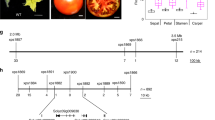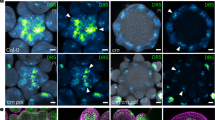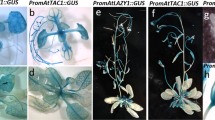Abstract
The size of an organism is genetically determined, yet how a plant or animal achieves its final size is largely unknown. The shoot of higher plants has a simple conserved body plan based on three major tissue systems: the epidermal (L1), sub-epidermal (L2) and inner ground and vascular (L3) tissues. Which tissue system drives or restricts growth has been a subject of debate for over a century1,2,3,4. Here, we use dwarf, brassinosteroid biosynthesis and brassinosteroid response mutants in conjunction with tissue-specific expression of these components as tools to examine the role of the epidermis in shoot growth. We show that expression of the brassinosteroid receptor or a brassinosteroid biosynthetic enzyme in the epidermis, but not in the vasculature, of null mutants is sufficient to rescue their dwarf phenotypes. Brassinosteroid signalling from the epidermis is not sufficient to establish normal vascular organization. Moreover, shoot growth is restricted when brassinosteroids are depleted from the epidermis and brassinosteroids act locally within a leaf. We conclude that the epidermis both promotes and restricts shoot growth by providing a non-autonomous signal to the ground tissues.
This is a preview of subscription content, access via your institution
Access options
Subscribe to this journal
Receive 51 print issues and online access
$199.00 per year
only $3.90 per issue
Buy this article
- Purchase on Springer Link
- Instant access to full article PDF
Prices may be subject to local taxes which are calculated during checkout




Similar content being viewed by others
References
Peters, W. S. & Tomos, D. The epidermis still in control? Bot. Acta 109, 264–267 (1996)
Kutschera, U. Stem elongation and cell wall proteins in flowering plants. Plant Biol. 3, 466–480 (2001)
Green, P. B. Connecting gene and hormone action to form, pattern and organogenesis: biophysical transductions. J. Exp. Bot. 45, 1775–1788 (1994)
Dale, J. E. The control of leaf expansion. Annu. Rev. Plant Physiol. Plant Mol. Biol. 39, 267–295 (1988)
Tsukaya, H. Mechanism of leaf-shape determination. Annu. Rev. Plant Biol. 57, 477–496 (2006)
Gendreau, E. et al. Cellular basis of hypocotyl growth in Arabidopsis thaliana. Plant Physiol. 114, 295–305 (1997)
Szekeres, M. et al. Brassinosteroids rescue the deficiency of CYP90, a cytochrome P450, controlling cell elongation and de-etiolation in Arabidopsis. Cell 85, 171–182 (1996)
Nakamura, A. et al. The role of OsBRI1 and its homologous genes, OsBRL1 and OsBRL3, in rice. Plant Physiol. 140, 580–590 (2006)
Nakaya, M., Tsukaya, H., Murakami, N. & Kato, M. Brassinosteroids control the proliferation of leaf cells of Arabidopsis thaliana. Plant Cell Physiol. 43, 239–244 (2002)
Vert, G., Nemhauser, J. L., Geldner, N., Hong, F. & Chory, J. Molecular mechanisms of steroid hormone signaling in plants. Annu. Rev. Cell Dev. Biol. 21, 177–201 (2005)
Fujioka, S. & Yokota, T. Biosynthesis and metabolism of brassinosteroids. Annu. Rev. Plant Biol. 54, 137–164 (2003)
Sessions, A., Weigel, D. & Yanofsky, M. F. The Arabidopsis thaliana MERISTEM LAYER 1 promoter specifies epidermal expression in meristems and young primordia. Plant J. 20, 259–263 (1999)
Choe, S. et al. The Arabidopsis dwf7/ste1 mutant is defective in the delta7 sterol C-5 desaturation step leading to brassinosteroid biosynthesis. Plant Cell 11, 207–221 (1999)
Cano-Delgado, A. et al. BRL1 and BRL3 are novel brassinosteroid receptors that function in vascular differentiation in Arabidopsis. Development 131, 5341–5351 (2004)
Turner, S. & Sieburth, L. E. Vascular Patterning. In The Arabidopsis Book (eds Somerville, C. R. & Meyerowitz, E. M.) (Am. Soc. Plant Biol., Rockville, Maryland, 2003)
Turk, E. M. et al. CYP72B1 inactivates brassinosteroid hormones: an intersection between photomorphogenesis and plant steroid signal transduction. Plant Physiol. 133, 1643–1653 (2003)
Neff, M. M. et al. BAS1: A gene regulating brassinosteroid levels and light responsiveness in Arabidopsis. Proc. Natl Acad. Sci. USA 96, 15316–15323 (1999)
Symons, G. M. & Reid, J. B. Brassinosteroids do not undergo long-distance transport in pea. Implications for the regulation of endogenous brassinosteroid levels. Plant Physiol. 135, 2196–2206 (2004)
Bishop, G. J., Harrison, K. & Jones, J. D. The tomato Dwarf gene isolated by heterologous transposon tagging encodes the first member of a new cytochrome P450 family. Plant Cell 8, 959–969 (1996)
Baima, S. et al. The expression of the Athb-8 homeobox gene is restricted to provascular cells in Arabidopsis thaliana. Development 121, 4171–4182 (1995)
Kurata, T., Okada, K. & Wada, T. Intercellular movement of transcription factors. Curr. Opin. Plant Biol. 8, 600–605 (2005)
Gallagher, K. L. & Benfey, P. N. Not just another hole in the wall: understanding intercellular protein trafficking. Genes Dev. 19, 189–195 (2005)
Yin, Y. et al. BES1 accumulates in the nucleus in response to brassinosteroids to regulate gene expression and promote stem elongation. Cell 109, 181–191 (2002)
Wang, Z. Y. et al. Nuclear-localized BZR1 mediates brassinosteroid-induced growth and feedback suppression of brassinosteroid biosynthesis. Dev. Cell 2, 505–513 (2002)
Pien, S., Wyrzykowska, J., McQueen-Mason, S., Smart, C. & Fleming, A. Local expression of expansin induces the entire process of leaf development and modifies leaf shape. Proc. Natl Acad. Sci. USA 98, 11812–11817 (2001)
Gleave, A. P. A versatile binary vector system with a T-DNA organisational structure conducive to efficient integration of cloned DNA into the plant genome. Plant Mol. Biol. 20, 1203–1207 (1992)
Acknowledgements
We thank Y. Belkhadir, M. Chen, N. Geldner and X. Wu for many thoughtful discussions and critical comments on the manuscript. We thank P. Sawchenko, LNSF, for access to microtomy, S. Mora-Garcia for help at the initial stage of the project and T. Gabi, S. Kim, E. Ballon-Landa, C. Butterfield and Z. Smith for technical assistance. This work was supported by grants from the National Science Foundation and the USDA to J.C. and by The Salk Institute and a Vaadia-BARD Postdoctoral Fellowship from BARD, The United States–Israel Binational Agricultural Research and Development Fund to S.S.-G. J.C. is an investigator of the Howard Hughes Medical Institute.
Author Contributions S.S.-G. and J.C. conceived and designed the experiments. S.S.-G. performed the experiments. C.P. performed plant anatomical sections. S.S.-G. and J.C. analysed the data and wrote the paper.
Author information
Authors and Affiliations
Corresponding author
Ethics declarations
Competing interests
Reprints and permissions information is available at www.nature.com/reprints. The authors declare no competing financial interests.
Supplementary information
Supplementary Information
This file contains Supplementary Figures 1-2 with Legends, Supplementary Methods and additional references. (PDF 1129 kb)
Rights and permissions
About this article
Cite this article
Savaldi-Goldstein, S., Peto, C. & Chory, J. The epidermis both drives and restricts plant shoot growth. Nature 446, 199–202 (2007). https://doi.org/10.1038/nature05618
Received:
Accepted:
Issue Date:
DOI: https://doi.org/10.1038/nature05618
This article is cited by
-
Persistence of parental age effect on somatic mutation rates across generations in Arabidopsis
BMC Plant Biology (2023)
-
Segmentation, tracking, and sub-cellular feature extraction in 3D time-lapse images
Scientific Reports (2023)
-
Functional copy number variation of CsSHINE1 is associated with fruit skin netting intensity in cucumber, Cucumis sativus
Theoretical and Applied Genetics (2022)
-
Plants on (brassino)steroids
Nature Plants (2021)
-
Guard cells control hypocotyl elongation through HXK1, HY5, and PIF4
Communications Biology (2021)
Comments
By submitting a comment you agree to abide by our Terms and Community Guidelines. If you find something abusive or that does not comply with our terms or guidelines please flag it as inappropriate.



